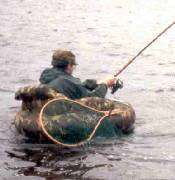Chumming
Chumming (American English from Powhatan)[1] is the practice of luring various animals, usually fish such as sharks, by throwing "chum" into the water. Chum is bait consisting of fish parts, bone and blood, which attract fish, particularly sharks owing to their keen sense of smell.[2][3][4] In Australia and New Zealand, "chum" is referred to as burley. "Ground bait" is the European term. The first phrase coined for chum was "offal", meaning rejected or wasted parts of killed animals including their internal organs.[5]
Native Americans used two methods of chumming. First, they would lie alongside a grasshopper and encourage it to jump into a flowing stream where the fish would consume the grasshopper. The Native Americans would then bait their hook with a grasshopper and hence catch the fish. Additionally, indigenous people would tie a dead animal from a tree above a stream encouraging flies to lay eggs. After weeks, the eggs become maggots and fell into the water bringing a concentration of fish into the area.[6]
Also known as rubby dubby (West Country and Yorkshire, UK),[7] shirvey or chirvey (Guernsey, Channel Islands), burley,[8] berley or berleying (Australasia),[9] and bait balls.
Chumming is illegal in some parts of the world (such as in the state of Alabama in the U.S.[10]) because of the danger it can pose by conditioning sharks to associate feeding with the presence of humans.
Chumming is a common practice seen as effective by fishermen all over the world, typically in ocean waters.[11] Multiple forms of chum are available and used by anglers. Bunker consists of fish parts with a fish-enticing aroma. Stink bait contains oily fish parts and blood that releases the scent of dead fish into the water.[12]
Florida restrictions for chumming include local laws in saltwater areas. Due to the vast barren sandy bottom structure around most of the state using chum is a necessity and common practice.[13] The Florida Fish and Wildlife Conservation Commission(FWC) approved changes to shark fishing regulations, including prohibiting chumming when fishing for any species from the beach. The new ruling went into effect July 1, 2019.[14]
See also
- Chum box, a form of internet advertising whose name is derived from the term.
References
- Siebert, Frank (1975), Crawford, James (ed.), "Resurrecting Virginia Algonquian from the dead: The reconstituted and historical phonology of Powhatan", Studies in Southeastern Indian Languages, Athens, GA, USA: University of Georgia Press, p. 290.
- Rudow, Lenny (2012), "Chapter 30. Inshore Chumming", Rudow's Guide to Fishing the Mid Atlantic, Geared Up Publications, ISBN 0978727800.
- Stearns, Bob (December 2001), "Get Chummy", Field & Stream: 96–97.
- Peschak, Thomas P. (2014), Sharks and People: Exploring Our Relationship with the Most Feared Fish in the Sea, University of Chicago Press, p. 160, ISBN 022604792X.
- https://www.floridagofishing.com/fish-chum/fish-chum-and-chumming.html
- http://www.kenschultz.com/
- "Shark Fishing - Whitby Sea Fishing". Whitby Sea Fishing. 2013-03-28. Retrieved 2016-06-19.
- Nardene Berry, Melinda Dresser (2012). "Pest Fish Removal and Uses in Lake Ngaroto" (PDF). NZ Landcare Trust. Archived from the original (PDF) on 2017-04-14.
- Bishop, tony, "Berley (ground-baiting)", Basics to Increase Catch Rates, www.bishfish.co.nz, retrieved 2016-06-01.
- Shark Baiting Regulation in Effect Archived 2008-11-20 at the Wayback Machine
- Starr, Joyce. "How to Chum and Bait Freshwater Fish | Trails.com". www.trails.com. Retrieved 2018-10-02.
- https://www.floridagofishing.com/fish-chum/fish-chum-and-chumming.html
- https://www.floridagofishing.com/fish-chum/fish-chum-and-chumming.html
- https://myfwc.com/news/all-news/shark-fishing-1/
